In their 2021/22 exhibition Craft is Cactus the Museum Angewandte Kunst, Frankfurt, constructed a very convincing argument for including craft in the cactus family, a very convincing argument for making the Craftoideae a fifth subfamily of the Cactaceae.
Yet while a very good argument, as we all know, much work remains to be undertaken on the classification of the Craftoideae, not least in context of their habitats: where does one find craft? Where do the Craftoideae prevail?
With the exhibition Craft as Myth. Between Ideal and Real Life the Museum Angewandte Kunst Frankfurt undertake a detailed field study of the Craftoideae, and in doing so allow for reflections on both contemporary craft and of future contemporary craft. On the future of craft.......
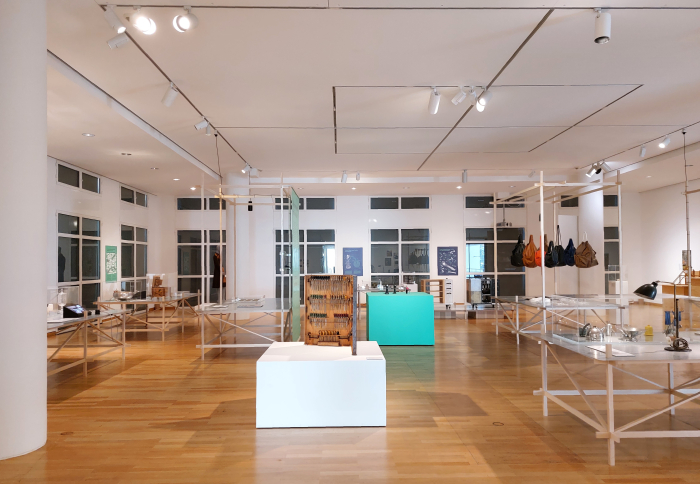
What is Craft?1
The question greets you in the second floor exhibition space of the Museum Angewandte Kunst, Frankfurt.
What is Craft?
One of those questions we're all quick to provide a confident answer to, answers invariably involving reference to hands, and traditions, and nature, and quality, and honesty, and humans, and cacti, etc, etc, etc. Answers tending to be supported in the Museum Angewandte Kunst, Frankfurt, by an accompanying gallery of paintings and photographs from across the globe and across (hi)story depicting various and varying aspects of, and representations of, craft. Answers which are, arguably, one of the reasons we all reflect so infrequently on craft, on what craft is. We all know.
And answers your initial reaction is to shield, to protect, from the curators' proposed answer: "... ein Mythos?", "... a Myth?"
As if!!, you reply, with an inaudible belligerence, just look at these paintings and photographs from across the globe and across (hi)story depicting various and varying aspects of, and representations of, craft, you retort. That, you assert, with a sweeping of your arm, is craft.
But then a creeping uncertainness caused by the curators insistent yet friendly "... a Myth?" forces you to look at the photographs and paintings more closely, and in doing so the appreciation slowly arises that the curators are toying with you and your understandings, the appreciation slowly arises that while many of the images presented may unquestionably be depictions of craft in action, there is also an awful lot of romanticising, idealising, canonising, staging, and a goodly portion marketing, mixed in. In your fresh uncertainty you find yourself reflecting that although it is a gallery illustrating craft, is it a gallery that illustrates what craft is?
What is Craft?
Where do the Craftoideae prevail?
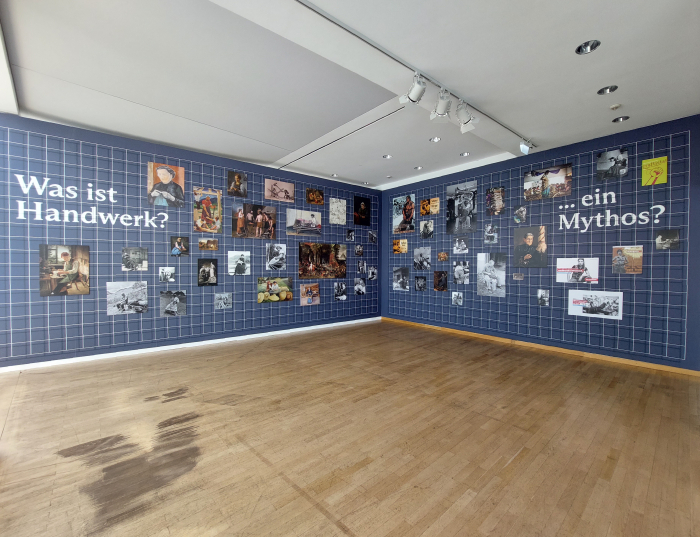
Questions Craft as Myth allows you to approach, re-approach, through six chapters, six chapters whose content freely intermingles, six chapters which stand in dialogue with one another, and thus six chapters which rather than providing for a fixed path through Craft as Myth, serve as a framework in which to develop your thoughts and positions on that which is presented, allow you the freedom to continually jump back and forth, and empower you to formulate and then re-formulate your own questions by way of response to the curators' questions.
For the What is Craft? that greets you at the entrance is just the first of many questions posed in and by Craft as Myth, Craft as Myth is very much an exhibition built on questions: each of the six chapters tackles an apparent conflict in understandings of craft, approaches juxtapositions inherent in popular understandings of craft, such as, for example, Hand and Head, Tradition and Progress, Luxury and Necessity through posing a wide-ranging question whose possible answers are subsequently approached through discussions on more specific questions.
Discussions on questions such as, for example, How is a craft learned? with its reflections on craft training since the 19th century; Why imitate the old? with its reflections on craft as both possessing a long tradition but also being something existent in the now; How much is craft worth to us? with its reflections on how one assesses the value of an object, what is contained in a value calculation? What ignored?
Or, How is mastery proven? A question posed in the chapter Mastery and Bricolage and which queries how informative is a certificate of qualification alone, ¿is the how you approach your understanding of your craft, how you interpret your craft, how you understand your role as a crafter in relation to wider society, not much more informative than being able to demonstrate your competence in the isolated elements of that craft? Or is it all about being formally qualified? A discussion on mastery versus a Master's certificate undertaken via a variety of objects contemporary and historical including a woollen dress developed in Dresden in 1948 by one Margarethe Zimmer2 as her Meister exam piece, a woollen dress created in context of the first Meister exams in Dresden after the War, and a woollen dress created against the background of, and very much as a creative response to, the contemporary material shortages in the immediate post-War Germanys. Shortages which, if one so will, Margarethe Zimmer mastered; and that in a work which in its carefully considered material usage, its maximising of a minimum, remains very contemporary. And also stands as a further reminder to all Instagramers that our objects of daily use are not primarily about the visuals. Regardless of how 😍 they may be.
And a work that also segues very neatly into the question posed in the chapter Hand and Head as to whether craftspeople make better designers?
¿?

A question that has been a component of discourses on the production of our objects of daily use since the earliest days of the 20th century, since the rise of industrial production in the late 19th century saw the traditionally unified form giving and production processes became separated, a rise that initially saw many industrialists imitate the old of craft before more enlightened voices asked a very pertinent why.
A question of craftspeople as designers approached in the chapter Hand and Head through works by four silversmiths: August Bock, a craftsman you've probably never heard of but who through his tenure as a teacher and mentor in the silversmith workshop at the Zeichenakademie in Hanau helped train, helped form, the other three featured silversmiths, three silversmiths you have almost certainly have heard of, if not necessarily in context of silver: Wilhelm Wagenfeld, Peter Raacke and Christian Dell, the latter of whom, and as oft opined in these dispatches, worked as the silversmith he was in the development of all his industrially produced lamp designs, not least the Rondella on show in Craft as Myth with its ever joyous swivel and height-adjusting solution. And a silversmith's approach Christian Dell also translated into his work as (arguably) the world's first plasticsmith, a translation that can be reflected on in Craft as Myth by a mustard pot Dell, in all probability, developed in ca. 1930 for Römmler AG. A 1930s plastic mustard pot that also asks why imitate the old.
A question of craftspeople as designers further approached in the chapter Unique Piece and Series through a highly entertaining cartoon by Karl Arnold from 19143 which in opining that Henry van de Velde makes unique chairs, Hermann Muthesius makes standardised chairs4 and the master carpenter makes "the chair to sit on", not only provides a succinct explanation of the basis of the so-called Typisierung debate of 1914, but also both focuses considerations on crafters as the better designers, on the why we need furniture designers, do they not after all just make everything more complicated with their concepts and positions, and also helps elucidate that the avant-garde have always been subject to popular ridicule, one thinks also, for example, and particularly appositely, of W. Heath Robinson and K. R. G. Browne's 1936 book How to live in a Flat and its teasing of chrome-plated steel tube furniture, International Modernist architecture and those who championed both. Or one thinks of the teasing in the 1970s of environmentalists and their demands for more considered resource use.
And a question of craftspeople as designers further re-approached in the question Is that craft or design?
A questioning undertaken via, for example, the above quoted Karl Arnold cartoon, a variety of ceramic objects developed by Ursula Fesca and Christian Neureuther for Waechtersbacher Steingutfabrik, including a fascinating and infinitely charming 1932 candlestick holder by Fesca, and also via a 1950s Ulmer Hocker and a 1905 chair from Richard Riemerschmid's so-called Maschinenmöbel, Machine Furniture, programme for the Deutsche Werkstätten Hellerau; both semi-industrial pieces employing contemporary engineering tools, but which are both heavily reliant on craft sensibilities, on craft practice. An interplay particularly elegantly elucidated in the Ulmer Hocker through the Fingerzinken, finger joints, a traditional carpentry approach but which, and as discussed from The Ulmer Hocker: Idea ─ Icon ─ Idol at the HfG-Archiv, Ulm, were realised mechanically in Ulm with the aid of a contemporary circular saw and a specially developed jig. And an early 20th century chair and mid-20th century stool which can both be considered forerunners of contemporary industrial furniture production, and thus embodiments of the, we'll argue truism, one also discussed from, for example, Glass – Hand Formed Matter at the Bröhan Museum, Berlin, that craft is an important source of inspiration for industry, that over the past 150ish years, 200ish if one considers a Michael Thonet, industry has continually looked to craft for new ideas, new impetuses, that the work of crafters, the research, and probing and challenging of crafters will inevitably find an, unthanked, unreferenced, industrial application.
That, if one so will, industry has continually harvested the fruits of the Craftoideae as an important source of nourishment.
And not only industry.

Does craft create identity? Does craft create a homeland? asks the chapter Local and Global, leading into a discussion on and reflections on associations between particular crafts and particular localities, a discussion on and reflections on the fact that localities often develop a competence and affinity in and for a particular craft or craft product, and a discussion on and reflections on that way marketeers and politicians, arguably more commonly political marketeers, position regions and towns as being the indigenous home of a particular craft, as the natural and only meaningful centre of that craft. A discussion on and reflections on the fruits of the Craftoideae as an important source of nourishment for the development of identities, of constructed identities and the associated tourist gaze of those from elsewhere, of craft as simultaneously a basis for both self-image and external image. And (thus) also the Craftoideae as an important source of nourishment for commerce; of constructed identities and indigenous craft claims as the basis for regional commerce. Aside from "Schwarzwald" cuckoo clocks, "Erzgebirge" woodcarving, "Scottish" tartan, we all recall, for example, Jørgen Roos' 1961 film Danish Design as featured in The Magic of Form – Design and Art at Kunsten Museum of Modern Art, Aalborg, and its assertion that "the reputation today enjoyed by Danish design is based on time-honoured tradition and quality craftsmanship"5, a claim that 60 years later is still the basis of all Danish furniture marketing. A claim invariably extended today by the abhorrent H****. But was it a valid claim in 1961? Is it a valid claim in 2022? Or is and was it the claim of a political marketing lurking between ideal and real life? And Murano Glass?
And in a same same but different manner Local and Global also asks Can craft survive without exchange?, a question which reminds very much of Cultural Affairs. Art without Borders at the Grassi Museum für Angewandte Kunst, Leipzig, and which as with Cultural Affairs allows for reflections on the exchange inherent in any craft practice, on the fact that over the centuries the fruits of the Craftoideae have served as an important source of nourishment for craft, that for all the political marketeers may seek to localize craft, isolate a given craft from all others, craft relies on cross-pollinations for its continuing existence. Something explored in Craft as Myth through discussions on, for example, the influence of China on the development of Europe porcelain, the influence of Japan in the development of Art Nouveau or the (hi)story of Indonesian batik. And which as with Cultural Affairs, and as with Konstantin Grcic. New Normals at Haus am Waldsee, Berlin, also allows for reflections on a possible near future global society where all forms of cultural inspiration and exchange are automatically called-out as cultural appropriation, as cultural colonisation, and where only practitioners social media deems as authentic, social media deems as possessing the correct identity, will be allowed to practice any given craft, and that according to a perceived correct, traditional, practice. Thereby ending cross-pollinations, that most vital of processes, and causing craft to become infertile, fruitless and irrelevant.
A threatened infertility, fruitlessness and irrelevance compounded by the reduction of craft to tourist kitsch or a chapter in the marketeers playbook or a component of a nefarious nationalism, and by the reduction of craft to a sideshow at Ye Olde Village Fayre or a carefully curated, static, academic, presentation of the Craftoideae in a cultural glasshouse through which we all stroll quicker, and less engaged, than we probably should.
¿And a threatened infertility, fruitlessness and irrelevance that could ultimately lead to craft's extinction?

We hear you, we hear you....... craft is cactus, and as we all know, the Cactaceae are nature's great survivors, are resilient, are versatile, can readily adapt, flourish in harsh conditions, revel in change.
Cactaceae don't become extinct.
Except they do.
Current research indicates that some 31% of cactus species are currently endangered6, and that 60-90% will be increasingly negatively impacted as we move forward7; and that not least by climate change and changing land use. By the changing realities in which they find themselves, by changes in and loses of their habitats.8
And much as it is in the power of all of us to contribute to avoiding the extinction of those other cacti, primarily through better understanding how we impact on their habitats and adjusting our behaviour accordingly, so to can better understanding the habitats of the Craftoideae allow us all to contribute to the preservation of craft. A preservation that as Craft as Myth helps one appreciate is, and as with the preservation of all plants, very much in all our interests.
A preservation which as Craft as Myth tends to argue requires as a necessary first step the development of an appreciation that craft today is often subjected to a romanticising, idealising, canonising, staging, and a goodly portion marketing. And long has been; arguably since the rise of industrial production in the late 19th century, since the rise of industrial production in the late 19th century saw the traditionally unified form giving and production processes became separated, we've tended to collectively romanticise, idealise, canonise craft as humane, as a natural human activity, as self-empowerment, as the honest labour of free individuals resisting the industrialist's slave wage, and in doing so began staging craft and incorporating craft in our marketing. And our politics.
Or put another way, craft isn't myth, but, and as Craft as Myth allows one to better understand, we tend to mythologise craft. And therefore the habitats we imagine the Craftoideae to inhabit, the habitats in which we expect the Craftoideae to prevail, are often as mythical as Valhalla, Endor, Hogwarts or wherever it is Donald Trump lives. With all the problems that causes for contemporary craft, whose true habitats we're largely blind to and thereby don't, can't, fully appreciate how we impact upon them.
And with all the problems that blindness, and impacting, and mythologising, will cause future craft.

Future craft reflected upon in Craft as Myth by, and amongst many other works, indigo-dying from the year 0 CE, a 17th century Delft vase, a 1930s bent tubular steel table and chair by Mart Stam or 1960s folded cardboard furniture by Peter Raacke. And future craft further reflected upon in Craft as Myth by, and amongst many other works, a collection of 3D printed vases by Olivier van Herpt, examples of Hella Jongerius's 3D weaving, Vincent Systems' VINCENTevolution4 electronic prosthetic hand, or by the film A Combmaker's Tale, specifically Antun Penezić's Tale, the tale of Croatia's last horn combmaker. The tale of a man who having trained as a combmaker in the 1950s, and who subsequently worked as combmaker, gave up his combmaking in the mid 1960s to take up a job in one of the new plastics factories that opened at that period in Zagreb, before returning to horn combs in his retirement, and that, as one understands from the film, with a great fondness and passion for his combmaking. A fondness and passion current generations, current youth, don't posses, and so with no-one to take on his workshop A Combmaker's Tale imagines a robot crafting horn combs.
A film which on the one hand allows for reflections on future relationships between technology and craft, on the future role of robots in craft processes, on digitalisation and artificial intelligence as craft's future. And also for reflections on relationships between crafts and societies: for all that we may find Antun Penezić a very sympathetic individual, for all we may allow ourselves to be freely drawn into his fondness and passion for horn combs, for all we may allow ourselves to become beguiled by the slow, delicate, determined crafting of horn combs and wonder at the results he so fondly and passionately realises.... do we actually need horn combs? Really? Combs, yes, at least for those of us with a quantity and volume of hair demanding of care. But from horn?
Back in the day horn was, alongside wood, ivory or tortoiseshell one of only very few materials from which one could craft combs, today we have other materials, going forward we will have ever more other materials. Horn combs are an anachronism in the 21st century. As are horn combmakers. Whether human or robot. Which, to repeat, is no reflection on Antun Penezić the man.
Thoughts which help highlight another understanding of Antun Penezić's Tale, another viewing of Antun Penezić's Tale.
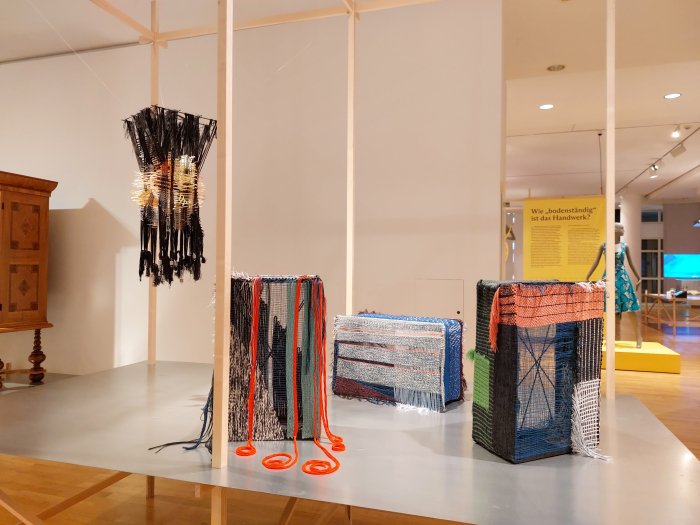
As we all recall, in 1948 Henry Massonnet transformed his father's horn comb manufacturing business into a plastics manufacturing business, a transformation undertaken in context of a general shift in manufacturing in the French Jura in the late 1940s/early 1950s away from horn and towards plastics. A shift towards plastic, as we learn from Antun Penezić's Tale, that occurred in Croatia at around the same time. Having moved from horn to plastic Henry Massonnet went on to develop the cheap, plastic, Monobloc chair, a chair that, arguably, made wooden chairs obsolete, anachronistic, which, arguably, continued the Maschinenmöbel tradition of a Richard Riemerschmid and, inarguably, provided new impetuses for the furniture industry. Thereby, certainly for us, very neatly illustrating, as do Olivier van Herpt's 3D printed vases, Hella Jongerius's 3D weaving, the Ulmer Hocker or the 17th century Delftware, craft becoming something new as society becomes something new, contemporary craft being related to the craft of generations past, but different, much as contemporary society is related to the society of generations past, but different.
And craft becoming something new, something related to the craft of generations past, but different, as materials become something new.9
For if one accepts, and you don't have to but it would be helpful if you pretended you did for the next few minutes, if one accepts that craft is intimately related to a material, if we accept that craft implies a close relationship with a given material, if we accept as Eva Linhart argues in the Craft is Cactus catalogue that "an essential prerequisite for craft creation is the mastery of the material"10, an opinion expressed in similar terms by Jørgen Roos in Danish Design11, if we accept that: does it matter what that material is? Must it always be the same material? And always the same process?
Is craft horn and wood and clay and wool and glass and leather and etc? Or is craft the production of objects of daily use from the most appropriate material?
Is craft an alternative to industrial production or low-level industrial production? Is craft a maintaining of tradition or a stewardship of tradition? Is craft a process or an approach? Is craft functional or decorative? Is craft individual or collective? Is craft early mornings or all day? Is craft a skill or an attitude? Is craft autonomous or dependent? Is craft a cultural enterprise or a commercial enterprise? Is craft democratic or autocratic? Is craft.......
.......or put another way, what is craft?
Where do the Craftoideae prevail?
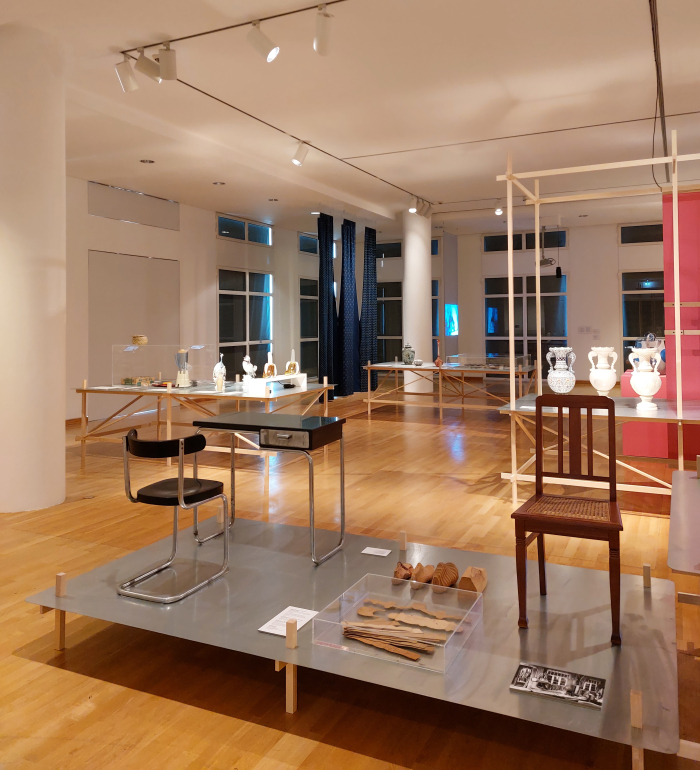
Undertaken by the Museum Angewandte Kunst, Frankfurt, in conjunction with the Kunstgewerbemuseum Dresden and the Vorarlberg Museum, Bregenz, both of whom one feels will be presenting it before all too long, and set in an exhibition design by Studio Kai Linke, as a field study Craft as Myth is also a stocktaking, a snapshot, of contemporary craft in context of historic and future references.
A field study which alongside its myriad objects and myriad questions, presents its results via a series of posters which visualise statistical aspects of crafts, and also via a number of videos in which contemporary craft practitioners answer further questions related to the six chapters, and thereby providing for a series of alternative insights on and takes on the umbrella questions of the respective chapters. And also, and not unimportantly, bringing a lot of different and disparate voices into the discussion, allowing access to different and disparate perspectives and understandings which can but aid and abet your own reflections and considerations. And your own questioning.
And a field study that presents itself not just as a breadth of objects in a breadth of media, but as a breadth of scope. A breadth of scope which surprises, but which shouldn't: craft pervades into (near) all aspects of our lives, of our societies, and therefore discussions on craft must do likewise. Yet rarely do. Rarely get beyond the process leading to the results. And which thus surprises when a discussion does. When a discussion on craft discusses, for example, craft practice as being an established component of industrial production, or discusses relationships between DIY and craft, discusses social structures of contemporary craft, discusses contemporary craft as a social structure, discusses craft as series, discusses the evolution of craft, discuses craft and gender, even if the statistics don't surprise, discusses copying as craft, discusses the demise of craft, etc, etc, etc...
If a breadth of scope which by necessity means that you are left to dig the depths for yourself; the discussions undertaken in Craft as Myth being, by necessity, brief, and the number of possible illustrations very naturally limited by space and time. However further digging Craft as Myth provides more than enough impetus and motivation to undertake. And a catalogue as a further aid, as a practical digging tool.12
And a breath of subject which is geographically restricted. For although featuring global examples of craft, and being a bi-lingual German/English presentation, Craft as Myth is very much a German focussed presentation, is very much a field study of the Craftoideae in Germany. Which isn't a complaint, far from it, the complaint, if we had a complaint, which we don't, but if we did, would be more the lack of Goethe and his lifelong study of and interest in Handwerk; given the German focus Goethe is very present in his absence. But the German focus per se isn't a complaint. On the one hand, any attempt to undertake a global field study would, one suspects, be doomed to failure given the very close relationships between crafts and societies, each society having its own relationship to craft, the habitats of the Craftoideae invariably showing regional variation. On the other hand, as a field study undertaken by Germanopohone institutions for show in Germanophone regions, it makes sense that it has a Germanic focus. And on the rare, and thus highly valuable third hand, through its highly concentrated and focussed reflections on the mythologising of craft in Germany Craft as Myth can also be employed as the basis for wider considerations on the contemporary German society in context of which craft exists, and thereby to enable a questioning of what and where does a further mythologising, or a demonising, occur in contemporary German society, which, yes, would bring one back to Goethe, were he present. And thereby allows for a wider questioning of contemporary and future German society, a questioning of contemporary German society as one between ideal and real life. A questioning that can be freely undertaken by both Germans and non-Germans alike.
But for all a breadth and variety that allows for reflections on and a questioning of contemporary and future craft. Through posing questions of craft without ever questioning craft, through discussing craft as being related to but not hands, and traditions, and nature, and quality, and honesty, and humans, and cacti, etc, etc, etc, through presenting craft as simultaneously, for example, Hand and Head, Tradition and Progress, Luxury and Necessity, simultaneously as Ideal and Real Life, Craft as Myth is a readily accessible and intelligently structured field study that provides one with time and space to better approach more probable answers to What is Craft? and Where do the Craftoideae prevail?
And thereby very neatly and satisfyingly helps advance and stimulate and promote the very important ongoing work on the classification of the Craftoideae.
Craft as Myth. Between Ideal and Real Life is scheduled to run at the Museum Angewandte Kunst, Schaumainkai 17, 60594 Frankfurt until Sunday September 11th
Full information, including information on opening times, ticket prices, current hygiene rules, and details of the accompanying fringe programme can be found at www.museumangewandtekunst.de/craft-as-myth
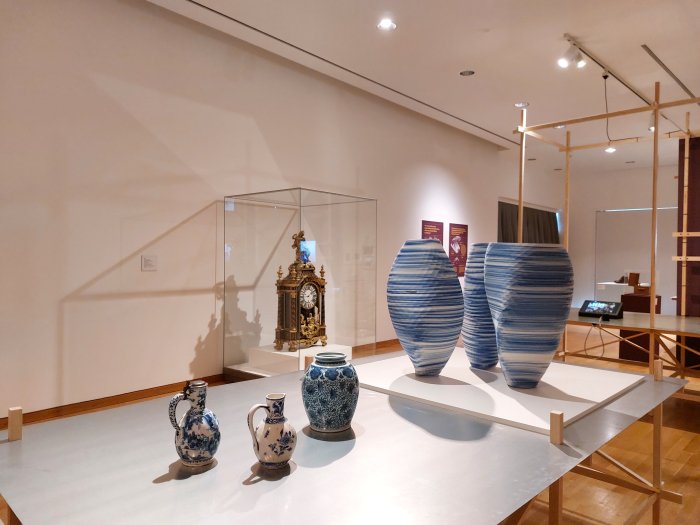



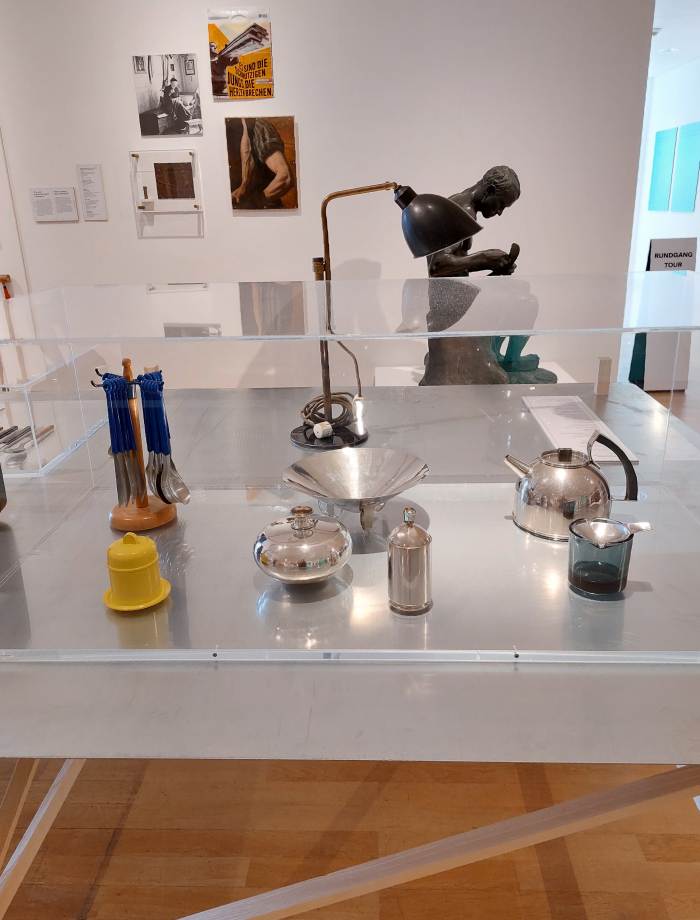

1The original German title is Mythos Handwerk, and while the term Handwerk is Craft, it isn't just, it also implies a level of professionalism, that one is qualified, has undergone formal training, aren't a dilettantish amateur, and also encompasses what in English would be trades, so, plumbing, roofing, scaffolding etc, and thus can be more correctly considered "professional manual work", manual as in manus/hands and as opposed to professional office work or professional educator or professional healthcarer or professional whatevers; however craft is inarguably a suitable translation, not least in context of Craft as Myth's main focus which is English craft not English trades, and so we'll stick with it here....
2We can find no information on Margarethe Zimmer and so have no idea what became of her and her craft after her qualification. Sorry....... Would however be interesting to know, not least because she qualified as a Meisterin in that period when creativity in the future DDR was still free, uninhibited, before the Formalism Debate of the early 1950s clouded the waters, clouded waters into which the political and econommic reality of the DDR regularly stuck their oars into.......
3Printed in Simplicissimus Vol. 19, Issue 18, 1914, page 285 Available online via http://www.simplicissimus.info/ (accessed 15.08.2022)
4The cartoon refers to a Stuhl-Type - model chair - and which is associated with the concept of Typenmöbel, a phrase which as previously noted isn't that simple to translate, requires paragraphs more than words, but can be considered as, and summarising more than is prudent, involving standardised families of furniture objects possessing the same structural and formal features which are universally applicable. Which sounds very familiar today, but was novel in the early 20th century and an important moment in the development of furniture design.
5Quote at around 15 minutes 58 seconds, is the closing statement Available via https://www.danmarkpaafilm.dk/film/danish-design (accessed 15.08.2022) And we can certainly recommend the film, not least as an extension of Craft as Myth's Do craftspeople make better designers?
6Bárbara Goettsch, Craig Hilton-Taylor, Kevin J. Gaston, et al, High proportion of cactus species threatened with extinction, Nature Plants, Vol 1, Issue 10, October 2015 We have admittedly only read the abstract. Sorry. But we can find no print edition near us, none of our institutions offer free access to the online articles, and given the scope in which we needed it, the access fee demanded was a little steeper than we could manage.... And we don't imagine that in the text the authors contradict or qualify the claims in the abstract to a degree to make them false. Scientists don't do cheap clickbait Abstract, and online access, available at https://doi.org/10.1038/nplants.2015.142 (accessed 15.08.2022)
7Michiel Pillet, Barbara Goettsch, Cory Merow et al, Elevated extinction risk of cacti under climate change, Nature Plants, Volume 8 Issue 4, April 2022 Also only the abstract. See FN 5 Sorry Abstract, and online access, available at https://doi.org/10.1038/s41477-022-01130-0 (accessed 15.08.2022)
8According to Bárbara Goettsch, Craig Hilton-Taylor, Kevin J. Gaston, et al, see FN 5, cacti are also increasingly endangered through "the unscrupulous collection of live plants and seeds for horticultural trade and private ornamental collections", a further fine example, were it needed, of the dangers posed to our planet by the human ego, and the urgent need for global society to finally move on from the ego......
9While contemporary mass production churning out thousands of Monoblocs every hour is clearly industry, we'd argue that there is an argument to be made that back in the 1950s production in synthetic plastics could be considered craft, and that Massonet's first Monoblocs arose from a development of that craft. And would certainly argue that plastics can be craft, would certainly argue for the validity of the plasticsmith as a craftworker.
10Eva Linhart, Abenteuer Kunsthandwerk in Sabine Runde and Matthias Wagner K [Eds.] Kunsthandwerk ist Kaktus, Arnoldsche, 2022 Which we still don't have a copy of, and so are still working from an advance copy of the essay we received in context of Craft is Cactus. Apologies if in the book the quote is absent or different.
11Quote at around 2 minutes 58 seconds Available via https://www.danmarkpaafilm.dk/film/danish-design (accessed 15.08.2022)
12Mythos Handwerk. Zwischen Ideal und Alltag, Verlag für moderne Kunst, 2022 As far as we are aware it is only available in German